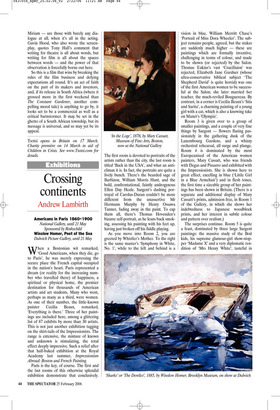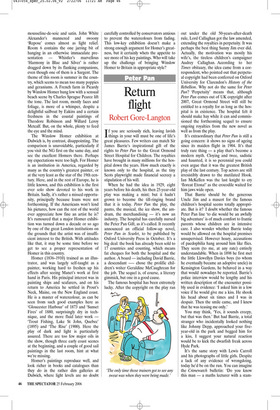Crossing continents
Andrew Lambirth
Americans in Paris 1860–1900 National Gallery, until 21 May Sponsored by Rothschild Winslow Homer, Poet of the Sea Dulwich Picture Gallery, until 21 May
When a Bostonian wit remarked, ‘Good Americans, when they die, go to Paris’, he was merely expressing the secure place the French capital occupied in the nation’s heart. Paris represented a dream (or reality for the increasing number who travelled there) of happiness, a spiritual or physical home, the premier destination for thousands of American artists and art students. Many who went, perhaps as many as a third, were women. As one of their number, the little-known painter Cecilia Beaux, remarked, ‘Everything is there.’ Three of her paintings are included here, among a glittering list of 87 exhibits by more than 30 artists. This is not just another exhibition tagging on the shirt-tails of the Impressionists. The range is extensive, the mixture of known and unknown is stimulating, the total effect deeply impressive. Such a relief after that half-baked exhibition at the Royal Academy last summer, Impressionism Abroad: Boston and French Painting.
Paris is the key, of course. The first and the last rooms of this otherwise splendid exhibition demonstrate that conclusively. The first room is devoted to portraits of the artists rather than the city, the last room is titled ‘Back in the USA’, and what an anticlimax it is. In fact, the portraits are quite a lively bunch. There’s the bearded sage of Barbizon, William Morris Hunt, and the bold, confrontational, faintly androgynous Ellen Day Heale. Sargent’s dashing portrayal of Carolus-Duran couldn’t be more different from the unassertive Mr Hermann Murphy by Henry Ossawa Tanner, fading away in the paint. To cap them all, there’s Thomas Hovenden’s bizarre self-portrait, as he leans back smoking, assessing his painting with his feet up, having just broken off his fiddle playing.
As you move into Room 2, you are greeted by Whistler’s Mother. To the right is the same master’s ‘Symphony in White, No. 1’, while to the left and behind is a vision in blue, William Merritt Chase’s ‘Portrait of Miss Dora Wheeler’. The subject remains people, agreed, but the stakes are suddenly much higher — these are paintings which are formally inventive, challenging in terms of colour, and made to be shown (or rejected) by the Salon. Thomas Eakins’s vast ‘Crucifixion’ was rejected, Elizabeth Jane Gardner (whose ultra-conservative biblical subject ‘The Shepherd David’ is quite horrid) was one of the first American women to be successful at the Salon; she later married her teacher, the much-reviled Bouguereau. By contrast, in a corner is Cecilia Beaux’s ‘Sita and Sarita’, a charming painting of a young girl with a cat, which is also a knowing take on Manet’s ’Olympia’.
Room 3 is given over to a group of smaller paintings, and a couple of very fine things by Sargent — flowers flaring passionately in the gathering dusk of the Luxembourg Gardens, and a whizzy orchestral rehearsal, all surge and plunge. Room 4 is dominated by the most Europeanised of the American women painters, Mary Cassatt, who was friends with Degas and Pissarro and exhibited with the Impressionists. She is shown here to great effect, excelling in blue (‘Little Girl in a Blue Armchair’) and in flesh tones, the first time a sizeable group of her paintings has been shown in Britain. (There is a separate and additional display of Mary Cassatt’s prints, admission free, in Room 1 of the Gallery, in which she shows her indebtedness to Japanese woodblock prints, and her interest in subtle colour and pattern over realism.) The surprises continue. Room 5 is quite a feast, dominated by three large Sargent paintings: the massive study of the Boit kids, his supreme glamour-girl show-stopper ‘Madame X’ and a very diplomatic rendition of ‘Mrs Henry White’, tasteful in mousseline-de-soie and satin. John White Alexander’s mannered and swoony ‘Repose’ comes almost as light relief. Room 6 contains the one jarring bit of hanging in an otherwise immaculate presentation — Whistler’s marvellous ‘Harmony in Blue and Silver’ is rather dragged down by its flanking companions, even though one of them is a Sargent. The theme of this room is summer in the country, which seems to mean too many poppies and geraniums. A French farm in Picardy by Winslow Homer hung low with a sensual beach scene by Charles Sprague Pearce lift the tone. The last room, mostly faces and foliage, is more of a whimper, despite a delightful sailboat by Eakins and a certain freshness in the coastal paintings of Theodore Robinson and Willard Leroy Metcalf. But, on the whole, plenty to feed the eye and the mind.
The Winslow Homer exhibition at Dulwich is, by contrast, disappointing. The comparison is unavoidable, particularly if you visit the NG first on the same day, and see the excellent Homers there. Perhaps my expectations were too high. For Homer is an institution in America, regarded by many as the country’s greatest painter, or at the very least as the star of the 19th century. Here, and in the rest of Europe, he is little known, and this exhibition is the first ever solo show devoted to his work in Britain. Sadly, it’s rather a missed opportunity, principally because loans were not forthcoming. If the Americans won’t lend his pictures, how can the rest of the world ever appreciate how fine an artist he is? It’s rumoured that a major Homer exhibition was turned down a decade or so ago by one of the great London institutions on the grounds that the artist was of insufficient interest to the British. With attitudes like that, it may be some time before we get to see a proper representation of Homer in this country.
Homer (1836–1910) trained as an illustrator, and was largely self-taught as a painter, working hard to freshen up his effects after seeing Manet’s work at first hand in Paris. His principal interest was in painting ships and seafarers, and on his return to America he settled in Prout’s Neck, Maine, on the New England coast. He is a master of watercolour, as can be seen from such good examples here as ‘Gloucester Harbour’ of 1873 and ‘Sunset Fires’ of 1880, surprisingly dry in technique, and the more fluid later work — ‘Trout Fishing, Lake St John, Quebec’ (1895) and ‘The Rise’ (1900). Here the play of dark and light is particularly assured. There are too few major oils in the show, though three early coast scenes at the beginning, and a couple of good sail paintings in the last room, hint at what we’re missing.
Homer’s paintings reproduce well, and look richer in books and catalogues than they do in the rather dim galleries at Dulwich, where light levels are no doubt carefully controlled by conservators anxious to prevent the watercolours from fading. This low-key exhibition doesn’t make a strong enough argument for Homer’s greatness, but it certainly whets the appetite to see more of his key paintings. Who will take up the challenge of bringing Winslow Homer to Britain in appropriate style?



































































 Previous page
Previous page